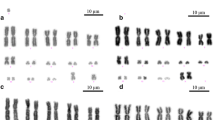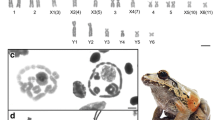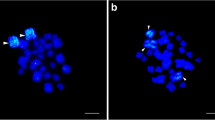Abstract
In the vast majority of spider species studied to date, the karyotype is homogeneous in morphology and exclusively telocentric. The sex-determining system consists of one to three X chromosomes in the male and, correspondingly, two to six in the female. This is the case in species of huntsman spiders belonging to the genera Heteropoda (2n=40+3X), Isopoda, Olios, and Pediana (2n=40+3X) and some populations of the colonial species Delena cancerides (2n=40+3X). In other populations of D. cancerides, wholesale fusion of the karyotype has occurred, reducing the standard huntsman karyotype of 43 telocentric chromosomes to 21 metacentrics and 1 telocentric. Eight of the centric fusion products, including an X-autosome fusion, are maintained in the heterozygous condition in males and, with the single telocentric, form a chain of nine chromosomes at meiosis. The two complexes comprising the chain behave as neo-X and neo-Y chromosomes, and thus the ancestral X1X2X3♂∶X1X1X2X2X3X3♀ sex-determining system has been converted to a system of six X and four Y chromosomes in the male and twelve X chromosomes in the female. Since sex-linked complex heterozygosity is also found in a number of species of social termites, it is suggested that such heterozygosity may have adaptive significance for a colonial lifestyle. Breakdown products of the chain of nine are present in specimens of D. cancerides from Canberra and these appear to represent hybrid products between the 2n=22 and 2n=43 forms. Hybridisation may also have been involved in the origin of the chain-forming races.
Similar content being viewed by others
References
Burgess JW (1978) Social behaviour in group-living spider species. Symp Zool Soc Lond 42:69–78
Capanna E, Gropp A, Winking H, Noack L, Civitelli MV (1976) Robertsonian metacentrics in the mouse. Chromosoma 58:341–353
Cleland RE (1972) Oenothera: Cytogenetics and Evolution. Academic Press, London, p 370
Darlington CD (1931) The cytological theory of inheritance in Oenothera. J Genet 24:405–474
Darlington CD (1973) Review: Oenothera, Cytogenetics and evolution by RE Cleland. Heredity 31:287–291
Gropp A, Winking H, Zech L, Muller H (1972) Robertsonian chromosomal variation and identification of metacentric chromosomes in feral mice. Chromosoma 59:265–288
Hogg HR (1902) On the Australian spiders of the subfamily Sparassinae. Proc Zool Soc Lond 2 (18):218–279
James SH (1965) Complex hybridity in Isotoma petraea I. The occurrence of interchange heterozygosity, autogamy and a balanced lethal system. Heredity 20:341–353
James SH (1970) Complex hybridity in Isotoma petraea II. Components and operation of a possible evolutionary mechanism. Heredity 25:53–77
James SH, Wylie AP, Johnson MS, Carstairs SA, Simpson GA (1983) Complex hybridity in Isotoma petraea V. Allozyme variation and the pursuit of hybridity. Heredity 51:653–663
John B, Quraishi HB (1964) Studies on Periplaneta americana IV. Pakistani populations. Heredity 19:147–156
Larson A, Prager EM, Wilson AC (1984) Chromosomal evolution, speciation and morphological change in vertebrates: the role of social behaviour. Chromosomes Today 8:216–228
Levin DA (1975) Genie heterozygosity and protein polymorphism among local population of Oenothera biennis. Genetics 79:477–491
Lewis KR, John B (1957) Studies on Periplaneta americana II. Interchange heterozygosity in isolated populations. Heredity 11:11–22
Maddison WP (1982) XXXY Sex chromosomes in males of the jumping spider genus Pellenes (Araneae:Salticidae). Chromosoma 85:23–37
Murtagh CE (1977) A unique cytogenetic system in monotremes. Chromosoma 65:37–57
Nash HR, Brooker PC, Davis SJM (1983) The Robertsonian translocation house-mouse populations of North East Scotland: A study of their origin and evolution. Heredity 50:303–310
Ogawa K (1954) Chromosome studies in the Myriapoda VII: A chain association of the multiple sex chromosomes found in Otocryptops sexspinosus (Say). Cytologia 19:265–272
Simon E (1880) Revision de la famille des Sparassidae [Arachnides]. Actes de la Société Linnéene de Bordeaux 225–351
Sbalqueiro IJ, Mattevitis, Oliveira LFB (1984) An X1X1X2X2/X1X2Y mechanism of sex determination in a South American rodent, Deltamys kempi (Rodentia, Cricetidae). Cytogenet Cell Genet 38:50–55
Syren RM, Luykx P (1977) Permanent segmental interchange complex in the termite Incisitermes schwarzi. Nature 266:167–168
Syren RM, Luykx P (1981) Geographic variation of sex-linked translocation heterozygosity in the termite Kalotermes approximatus Snyder (Insecta:Isoptera). Chromosoma 82:65–88
Vincke PP, Tilquin JP (1977) A sex-linked ring quadrivalent in Termitidae (Isoptera). Chromosoma 67:151–156
Webb GC (1976) Chromosome organization in the Australian plague locust Chortoicetes terminifera. I. Banding relationships of the normal and supernumery chromosomes. Chromosoma 55:229–246
Wiens D, Barlow BA (1979) Translocation heterozygosity and the origin of dioecy in Viscum. Heredity 42(2):201–222
Author information
Authors and Affiliations
Rights and permissions
About this article
Cite this article
Rowell, D.M. Complex sex-linked fusion heterozygosity in the Australian huntsman spider Delena cancerides (Araneae: Sparassidae). Chromosoma 93, 169–176 (1985). https://doi.org/10.1007/BF00293165
Received:
Revised:
Issue Date:
DOI: https://doi.org/10.1007/BF00293165




